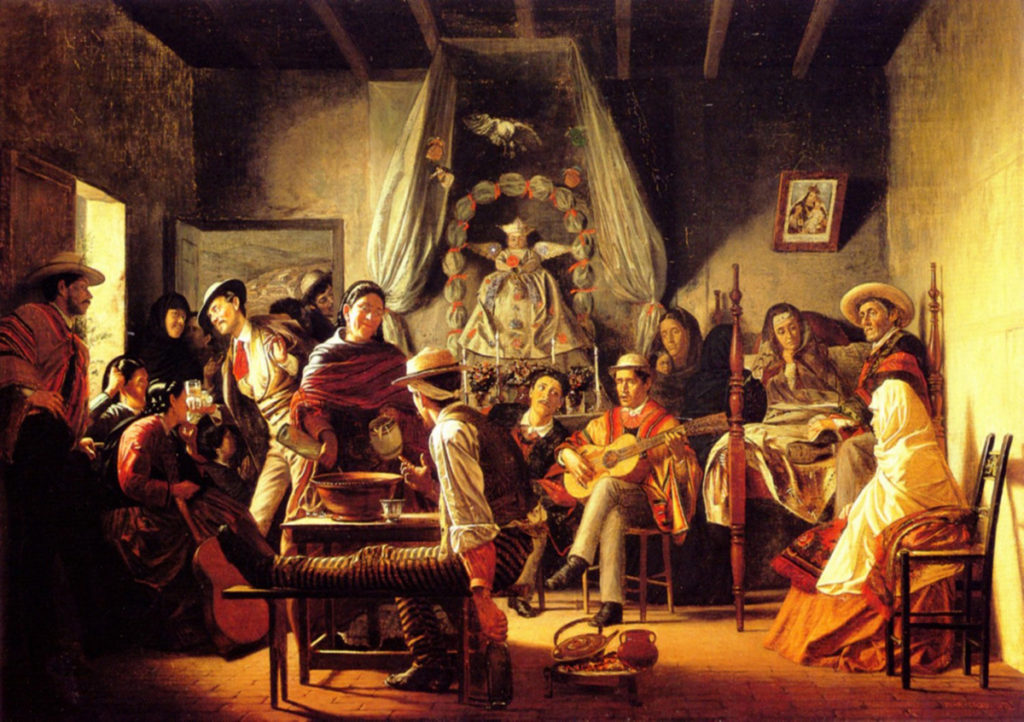Contexts and performances

Fig. 3.1. A velorio de angelito, in the 19th century. Painting by Antonio Caro (1835-1903).
Contexts
As an intrinsic expression of the rural world, canto a lo poeta reflects its rhythms, calendar and rituals. The poet-singers traditionally perform in the private spaces of homes, at the invitation of the hosts, who offer the guests hospitality, food and drink. The canto a lo humano is sung at wedding celebrations, baptisms and birthdays, or in moments of rest and recreation, at the end of a day of communal farm work, or even on the fringes of a religious festival. On the same occasions, the paya, a contest of poetic improvisation, is also held. Canto lo divino, on the other hand, is performed during funeral wakes, novenas, or religious festivities, such as the Cruz de Mayo or festivities dedicated to the Virgin Mary. Special consideration is given to the wake of a dead child (velorio de angelito), one of the most important and demanding artistic duties for cantores of canto a lo divino. During these wakes, once very frequent due to the high infant mortality rate in rural areas, but nowadays fortunately much rarer, the role of the singers is to help the family elaborate their mourning and by expressing the community’s spiritual values achieve a return to life, apparently negated by a tragic event that is difficult to accept. The wake follows a precise ritual, ending with the cantor interpreting the role of an angel addressing the child’s parents to console them for their loss, as he or she ascends directly into heaven [Fig. 3.1].
In recent times, canto a lo poeta has spread to new contexts, including urban situations, acquiring the dimension of public shows. On one hand, canto a lo divino has been accommodated in liturgical spaces, thus serving the Catholic Church through its considerable potential to attract congregations. And on the other hand, canto a lo humano, and especially paya, now features in public events, such as concerts, festivals and dedicated meetings of enthusiasts at local, national or international level.
In the two videos on this page, ethnomusicologist Claudio Mercado and singers Roberto Carreño and Erick Gil illustrate some aspects of performing and discuss new practices emerging alongside more conservative and traditional ones. The resulting picture is of an evolving cultural complex, whose vitality is closely linked to its capacity to incorporate and elaborate even radical changes to the codes of the genre.
Video 3.1: Contexts and performances: la rueda de cantores
In canto a lo poeta, even when the singing and the accompaniment are performed by different persons, the cantor is always a soloist. When several singers are present, they perform in turns, one at a time. This practice, however, can also take on a collective character, evident in the case of the rueda de cantores.
In the first video, Claudio Mercado outlines the context of the traditional use of canto a lo divino and then describes the performative mechanism of the rueda. In the development of the rueda (literally “wheel” or “circle”), the singers take turns following a cyclical rotation, until they create a kind of extended “meta-poem”, which focuses on a single topic (fundado, or fundamento) but is actually the result of the interweaving of their respective, different compositions (versos). A rueda may last all night long, from dusk to dawn, passing from one fundado to the next, and alternating the singing of canto a lo poeta with other songs and dances.
This procedure is still followed today, albeit with significant changes compared to the customs of the past. Previously, the rueda was normally accompanied by a single instrumentalist, repeating the same entonación (melody), to which each singer had to adapt, thus generating an iterative, hypnotic effect. Nowadays, however, in the Pirque area, the individual cantores accompany themselves, with their own entonación and corresponding toquío (style of accompaniment), creating a discontinuity in the music that considerably reduces the possibility of generating a hypnotic state. There is no doubt, however, that the effort of staying awake all night while remembering a huge number of lines of verse and adapting to the fundados proposed from time to time without repeating stanzas already sung by colleagues, involves a profound, intense psycho-physical experience in a demanding situation pushing the performers to their limits.
Video 3.2: Performances – continuity and change
In the second video, the ethnomusicologist and the singers discuss the different uses of canto a lo divino and canto a lo humano. While the former is still conditioned by the performer’s religious sentiment, the latter appears to be developing in the direction of larger public performances, especially the art of paya (improvisation). In this field, exchanges with other Latin American currents of repentismo (poetic improvisation) has been crucial and has raised the poetic, musical and performing standards, especially of younger performers. The change can be seen in the emergence of a new generation of singers who have had a very good grounding and are willing to experiment with non-canonical forms, both in the use of instruments and in going beyond traditional codes, as for example, with the growing presence of female performers of canto a lo poeta.
